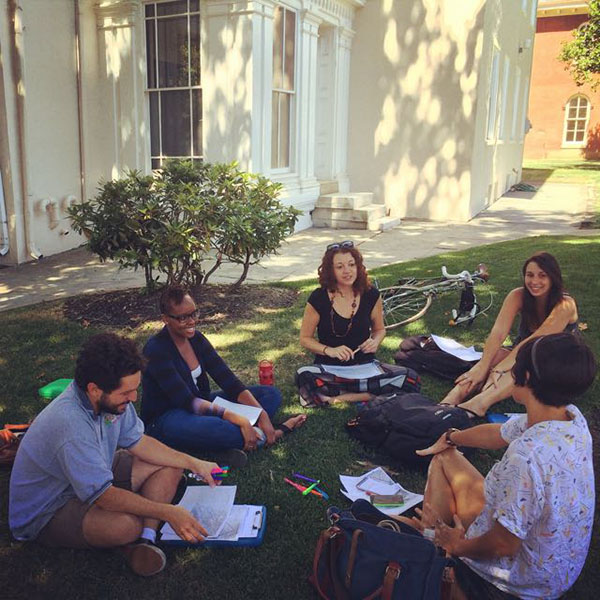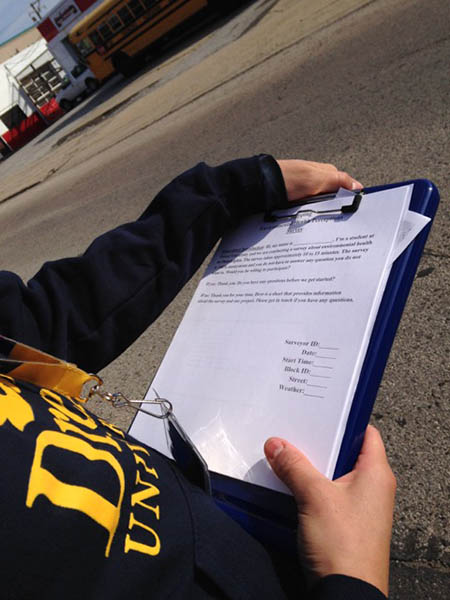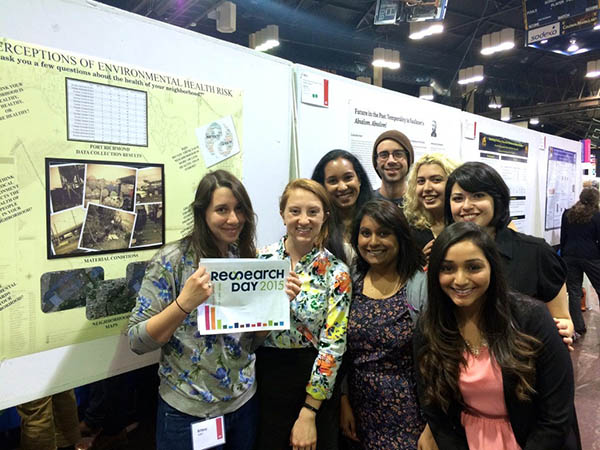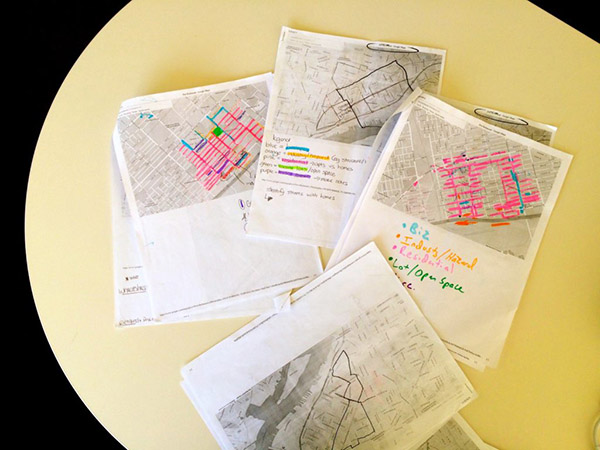Editor’s Note: This is the third entry in the Second Project Series. You can read the second post here. This series explores an often undiscussed moment in professionalization: the shift from the research you began as a graduate student to the new work undertaken as an early- or mid-career scholar. This series is especially interested in personal journeys and institutional features that enabled or constrained this transition. If you are interested in contributing, please contact Lisa.
Monday afternoons at least a dozen students and I gather to work on a collaborative ethnographic project. Some weeks we meet around a long, boardroom style table where we discuss article outlines, literature reviews, and “findings” crafted by our team members. Other weeks we organize around a handful of circular tables where small working groups tackle different pieces of the project—analyzing quantitative data using SPSS, creating GIS maps, coding qualitative survey questions, or co-writing a white paper, which we hope to have ready by the end of the year. About a third of these students have worked on the project since September 2014, when we conducted a door-to door survey across three Philadelphia neighborhoods. Others have joined the team along the way, interested in learning social science research on an active project. Many more, who worked on the first leg or two of the project, have since graduated. Most have stayed in touch and a few continue to collaborate with our group in some way, as professionals in nonprofits or community-based organizations, and also as graduate students in PhD and Master’s programs elsewhere. Among our group there is a real sense of community built around engaged interdisciplinary research focused on environmental health; this sense has been cultivated pedagogically through research design.

PHEEL research meeting at Drexel’s Dornsife Center in Philadelphia. August 2015, photo by author.
Across academic contexts, teaching and research are treated separately, and are often pitted against each other. Research, we are told, comes first and teaching, second. To me, the outcomes of such division are ethically problematic. I also believe this division misrepresents our intellectual lives and scholarship. My second project is as much about addressing this misrepresentation as it is environmental health, technoscience, and urban landscapes. There is no question in my mind that teaching research, and collaborating with students has made me a better scholar.
My work at Drexel began with a project titled “Mapping Perceptions of Environmental Health Risk,” which was funded by a seed grant from Drexel’s Social Science Council. This particular round of grants supported interdisciplinary collaboration within and beyond the College of Arts and Sciences; my co-PIs are based in public health (Igor Burstyn, an associate professor of environmental and occupational health in Drexel’s School of Public Health, and John Lee, Community and Environmental Health Director at Clean Air Council). Our project investigates how people perceive and get information about everyday environmental hazards; we look specifically at how urban redevelopment and gentrification shape perceptions and political capacity by comparing experiences in different neighborhoods in one of Philadelphia’s late industrial planning districts. The bulk of our data was collected over a 12-week period where students canvassed three zip codes and knocked on more than 3,330 doors. By design, the “Mapping Perceptions” project could not have happened without our student research team.

A Drexel University student conducting fieldwork for the ‘Mapping Perceptions’ project. November 2014.
In contrast to my first book project—an ethnography of asthma, environment and care in the U.S.—my second project is grounded in research design that emphasizes mentorship and builds an interdisciplinary social science research community that includes students, community members, and other organizations. This work has been well supported at Drexel University’s Center for Science, Technology and Society (CSTS); the University is organized by the cooperative education model and there is a strong culture of working with and alongside students. Drexel’s Master’s of Public Health program, for example, requires both a practicum and a community-based project for graduation. I highlight collaboration, mentoring, and project organizing in this short post because this defines my role as a tenure-track faculty member: the move from student to professor has meant figuring out how to teach STS in various contexts (our STS graduate program, as a faculty member in the Department of Politics and an interdisciplinary collaborator, and also in the Philadelphia community). For me personally, I find teaching research to be a highly effective strategy for teaching STS, social and political theory, and ethnography. Bringing students into projects for hands-on research experience allows them to carve out their own questions with theories, grapple with ethics, and work collaboratively with peers and faculty. Teaching research is also how I maintain an active research program as a junior faculty. Collaboration helps with accountability.

Students from PHEEL presenting their collaborative analyses at Drexel’s Student Research Day. June 2015.
Much of my academic training has been anchored in the tradition of collaborative learning and research. As a member of the University at Albany Women’s Studies Teaching Collective (2002-2003), I had my first experience with co-teaching and collaborative course design involving faculty and students. Years later, I brought the tools from feminist pedagogy and the Teaching Collective to a service learning course, which I taught at Rensselaer Polytechnic Institute. During a two-year window between finishing my dissertation and starting at Drexel, I taught and advised the Senior Projects course for RPI’s STS undergraduates. I also managed Cultural Anthropology’s Editorial Intern Program from 2008-2013, itself project oriented and collaborative. Taken together, these experiences translated into many hours working with students to develop and execute social science projects of different kinds. The rubrics and activities I used in these settings have been imported to the research group I run at Drexel. I’ve also drawn inspiration from The Matsutake Worlds Research Group, The Asthma Files (which I have been a member of since 2008), Part.Lab, the Civic Laboratory for Environmental Action Research, The Ethnography Studio, and CoLED, among others. My second project has been modeled off elements from these endeavors, albeit mostly in bits and pieces rather than systematically. The point is, my interest and commitment to teaching research started somewhere else, years ago. It’s a project that has been a decade in the making.
Balancing act
There are trade-offs. On the “Mapping Perceptions” project, for example, I assumed that I would be conducting surveys alongside students. The reality was, project management on a study this size is very, very, time consuming; I was lucky to get one day a week in the field. I was also unprepared for how long it would take to enter, clean and analyze a dataset this size—almost 350, 26-question surveys, plus observational data for 240 blocks. Letting students formulate their own research questions and giving them the structure to follow different leads has meant that there are many mini-projects to care for—and keep in conversation. The liveliness of collaborative work, however, and the experimental edge that comes from sharing ownership with students—this has made our project more robust.
Research training, for example, provides excellent points to check in on ethics, study design, and analytic conclusions. At the start of the 2016 winter term, two new students joined the project team. Not having participated in fieldwork or our first analytic pass on the data sets, both students began their own data analysis using the thematic categories we had set months before. As they worked through our first analysis, both students asked nuanced questions about how the survey had been administered, how the categories had been constructed, and why we chose to focus on some responses and not others. The team’s responses to these inquiries led to discussion, reflection, and always new perspectives and insights; in some cases, changing the course of the project.

Maps from early fieldwork when the research team started to learn about the neighborhoods where we would be conducting the survey. August 2014, photo by author.
The biggest trade-off, in my mind, is that the work has been slow. Although the seed grant supported the project for the first 18 months, the team has proceeded informally for the last year and a half as an ethnography lab. The Philadelphia Health and Environment Ethnography Lab (PHEEL) operates in the tradition of a weekly reading or writing group. But instead of reading an article or book together, or exchanging writing drafts, we gather weekly to work with and discuss data and methods. Sometimes this involves reading articles, or workshopping drafts of publications-in-progress, but our agenda is guided by an iterative research process that is anchored in the Mapping Perceptions project and data set. Students formalize their time and effort on the project through independent studies, practicums, and work study positions; most, however, are happy to come and learn research less formally. I keep a lookout for moments and spaces to teach research in, too, such as Drexel’s STS Lab seminar and community-based learning courses. Beyond these spaces, I have enjoyed styling PHEEL as a STS research meet-up. This format has allowed our group to work on dimensions that sometimes get short shrift—such as a contract for collaborators. Opening up and sharing the research process—and with it, data and analysis—produces different kinds of vulnerabilities for me, as a tenure-track professor. The value of collaboration and its pleasures, however, outweigh these vulnerabilities.
In sum, figuring out how to teach research has helped me conduct research, deepening my own scholarship. Intentionally bridging these two activities works against the teaching-research divide that, in my opinion, too often and erroneously gets reinforced in higher education.
